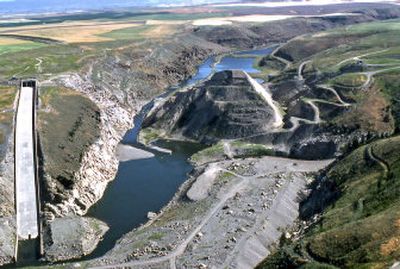Remnants of failed Teton Dam still unrestored

BOISE – When the leaking face of the brand-new Teton Dam gave way on June 5, 1976, and 80 billion gallons of water surged down a valley of eastern Idaho farming towns, it left behind the lakebed, empty except for mud and debris from landslides as banks caved in.
Three decades later, hundreds of millions of dollars of community rebuilding has left few signs of the devastation downstream from the broken dam, where a wall of water moving at 15 miles an hour killed 11 people and swallowed hundreds of homes and 18,000 head of livestock.
Yet upstream from the earthen pyramid remnant of the dam, the drained bathtub of the Teton Basin remains unrestored, undeveloped and undiscovered.
A new study by the federal agency that built the defective dam finds many area residents prefer to keep it that way.
“We didn’t hear what we thought we would, and that was a desire for developed recreation and more access,” said Vicki Kellerman, a recreation planner for the U.S. Bureau of Reclamation in Boise. “What folks told us instead was they did not want to see big boat launches and campgrounds. They want to keep it the way it is.”
The bureau’s new environmental assessment for the Teton River Canyon is the first time since the dam burst that the agency has addressed the question of what to do with the drained reservoir. The so-called “mass wasting event” triggered 200 landslides upstream from the dam, located about 20 miles northeast of Rexburg in eastern Idaho near Grand Teton National Park.
Kellerman said the 30-year delay in considering the empty lake’s future stems from indecision over the Teton Dam itself. Despite the disaster and two subsequent investigations that faulted Reclamation for siting an earthen dam in a valley of porous clay, some still want the dam rebuilt.
“After the failure, there was a lot of interest in rebuilding the dam. And with the drought we’ve had, there are still folks who would like to see it rebuilt because the needs for irrigation are still there,” said Kellerman. “So, we’ve been in an extended hold mode and finally decided if we are going to be responsible for managing those lands, we need a cohesive plan.”
The less-than-enthusiastic reaction by residents in the downstream communities to any proposal to transform the Teton River Canyon into a developed recreation site reflects the segment of the population that still hopes to see the dam rebuilt, said author and Idaho historian Cort Conley.
“Some of the bureaucrats in the Bureau of Reclamation have never given up that a political consensus might someday come to rebuild the dam in a slightly different location, so they’ve never been eager to do any restoration,” said Conley. “There will always be agriculture interests who insist rebuilding is a good possibility. But given the condition of the federal treasury now, it doesn’t look like it is going to be on the drawing board.”
The sense of limbo extends to the dam’s place in history and the lack of any roadside explanation of what Conley describes in his “Idaho For the Curious” guidebook as “one of the most bizarre scenes in the West,” the still-standing pillar of destroyed dam.
The site is expected to be nominated to the National Register of Historic Places, but Kellerman said repeated vandalism of previous markers has discouraged Reclamation from trying to post signs for tourists.
“There’s no denying that a tragedy occurred there, but when you have interpretive structures in isolated areas without any occupied facility nearby, it generally doesn’t work,” she said. “Still, engineers come from all over the world to look at this site.”
What today’s half-eaten Teton Dam represents to dam-builders is a turning point in safety and preparedness, said Larry Wolf, who manages dam safety programs for the Bureau of Reclamation in the Pacific Northwest.
“Before Teton, we did review maintenance and operations but we didn’t have a safety of dams program and inspections like we do today,” said Wolf, who has guided engineers on tours of the failed dam site. “We do things the way we do today because of the lessons we learned at Teton.”
Some of those who witnessed the 300-foot-high, 3,100-foot-long dam crumble firsthand say there is an institutional reluctance within the Bureau of Reclamation to draw attention to the failure.
“It’s a sore spot for the bureau because it’s the only dam they ever lost,” said Lew Payne, at the time a concrete superintendent for the dam’s contractor, Morrison-Knudsen. Payne was called in to work just hours before the dam gave way to supervise a vain attempt to plug what began as a 4-foot-by-4-foot hole on the downstream face of the dam.
As he watched, a Caterpillar bulldozer suddenly sank into the dam up to its belly pan. Another bulldozer was brought in to pull the first out of the widening leak.
“A few minutes later it belched again, and the men jumped off the Cats,” said Payne. “The water took the Cats like they were Tinker Toys.”
Less than six hours later, the entire Teton Reservoir had drained down the valley. The bulldozers were never found.
Wolf said evidence that may have provided more clues to the dam’s cataclysmic failure was washed away with the torrent. Left behind was a broken dam and empty lake, looking much the same today as it did 30 years ago.
“Even if you wanted to go in there and build a Disneyland, it’s a pretty tough place,” said Kellerman. “That may be part of what has preserved it the way it is for so long.”